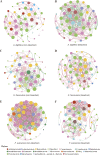Bacterial Communities Vary from Different Scleractinian Coral Species and between Bleached and Non-Bleached Corals
- PMID: 37191552
- PMCID: PMC10269541
- DOI: 10.1128/spectrum.04910-22
Bacterial Communities Vary from Different Scleractinian Coral Species and between Bleached and Non-Bleached Corals
Abstract
Bleaching is one of the most relevant factors implicated in the integrity of coral reef ecosystems, with the increasing frequency and intensity of damaging events representing a serious threat to reef biodiversity. Here, we analyzed changes in coral-associated bacteria from three types of non-bleached and bleached scleractinian corals (Acropora digitifera, Galaxea fascicularis, and Porites pukoensis) in Hainan Luhuitou peninsula coastal areas. The community structure of symbiotic bacteria differed significantly among the three apparently healthy corals. The bleached corals had higher bacterial alpha diversity and some specific bacteria genera, including Ruegeria, Methyloceanibacter, Filomicrobium, Halioglobus, Rubripirellula, Rhodopirellula, Silicimonas, Blastopirellula, Sva0996 marine group, Woeseia, and unclassified_c_Gammaproteobacteria, were consistently increased in bleached groups. Network analysis revealed significantly different degrees of modularity between bleached and non-bleached groups at the bacterial genus level, and a higher proportion of links was dominated by positive co-occurrences. Functional prediction analysis illustrated that coral-associated bacteria remained relatively consistent in the bleached and non-bleached groups. Structure equation modeling revealed that the bacterial community diversity and function were directly influenced by host and environment factors. These findings suggested that coral-associated bacterial responses to bleaching occur in a host-dependent manner, informing novel strategies for restoring coral and aiding adaption to bleaching stress. IMPORTANCE Accumulating evidence indicates that coral-associated bacteria play an important role in the health of holobionts. However, the variability of the symbiotic bacterial community structure among coral species with different coral health statuses remains largely unknown. Here, we investigated three apparent non-bleached (healthy) and bleached coral species (sampled in situ), involving related symbiotic bacterial profiles, including composition, alpha diversity, network relationship, and potential function. Structural equation modeling analysis was used to analyze the relationship between coral status and abiotic and biotic factors. The bacterial community structure of different groups was shown to exhibit host-specific traits. Both host and environmental impacts had primary effects on coral-associated microbial communities. Future studies are needed to identify the mechanisms that mediate divergent microbial consortia.
Keywords: bacterial communities; bleaching; coral health status; host-dependent profile; network relationship.
Conflict of interest statement
The authors declare no conflict of interest.
Figures







Similar articles
-
Mitigation of Vibrio coralliilyticus-induced coral bleaching through bacterial dysbiosis prevention by Ruegeria profundi.Appl Environ Microbiol. 2024 Apr 17;90(4):e0227423. doi: 10.1128/aem.02274-23. Epub 2024 Mar 12. Appl Environ Microbiol. 2024. PMID: 38470181 Free PMC article.
-
Prokaryotic and eukaryotic microbial communities associated with coral species have high host specificity in the South China Sea.Sci Total Environ. 2023 Apr 1;867:161185. doi: 10.1016/j.scitotenv.2022.161185. Epub 2022 Dec 27. Sci Total Environ. 2023. PMID: 36581277
-
Bleached coral supports high diversity and heterogeneity of bacterial communities: Following the rule of the 'Anna Karenina principle'.Environ Res. 2024 Dec 1;262(Pt 2):119977. doi: 10.1016/j.envres.2024.119977. Epub 2024 Sep 13. Environ Res. 2024. PMID: 39265759
-
The coral microbiome in sickness, in health and in a changing world.Nat Rev Microbiol. 2024 Aug;22(8):460-475. doi: 10.1038/s41579-024-01015-3. Epub 2024 Mar 4. Nat Rev Microbiol. 2024. PMID: 38438489 Review.
-
The Vulnerability and Resilience of Reef-Building Corals.Curr Biol. 2017 Jun 5;27(11):R528-R540. doi: 10.1016/j.cub.2017.04.047. Curr Biol. 2017. PMID: 28586690 Review.
Cited by
-
Diversity, composition and potential roles of sedimentary microbial communities in different coastal substrates around subtropical Okinawa Island, Japan.Environ Microbiome. 2024 Jul 30;19(1):54. doi: 10.1186/s40793-024-00594-1. Environ Microbiome. 2024. PMID: 39080706 Free PMC article.
-
Microbiome Composition in a Common Mediterranean Bryozoan Following an Unprecedented Marine Heatwave.Environ Microbiol Rep. 2025 Oct;17(5):e70185. doi: 10.1111/1758-2229.70185. Environ Microbiol Rep. 2025. PMID: 40905407 Free PMC article.
-
The Impact of Highly Weathered Oil from the Most Extensive Oil Spill in Tropical Oceans (Brazil) on the Microbiome of the Coral Mussismilia harttii.Microorganisms. 2023 Jul 29;11(8):1935. doi: 10.3390/microorganisms11081935. Microorganisms. 2023. PMID: 37630495 Free PMC article.
-
Interactive effects of ocean acidification and warming disrupt calcification and microbiome composition in bryozoans.Commun Biol. 2025 Jul 31;8(1):1135. doi: 10.1038/s42003-025-08524-8. Commun Biol. 2025. PMID: 40745023 Free PMC article.
-
Mitigation of Vibrio coralliilyticus-induced coral bleaching through bacterial dysbiosis prevention by Ruegeria profundi.Appl Environ Microbiol. 2024 Apr 17;90(4):e0227423. doi: 10.1128/aem.02274-23. Epub 2024 Mar 12. Appl Environ Microbiol. 2024. PMID: 38470181 Free PMC article.
References
-
- Rohwer F, Seguritan V, Azam F, Knowlton N. 2002. Diversity and distribution of coral-associated bacteria. Mar Ecol Prog Ser 243:1–10. doi: 10.3354/meps243001. - DOI
-
- Falkowski P, Dubinsky Z, Muscatine L, Porter J. 1984. Light and the bioenergetics of a symbiotic coral. Bioscience 34:705–709. doi: 10.2307/1309663. - DOI
-
- Muscatine L, McCloskey LR, Marian RE. 1981. Estimating the daily contribution of carbon from zooxanthellae to coral animal respiration. Limnol Oceanogr 26:601–611. doi: 10.4319/lo.1981.26.4.0601. - DOI
-
- Rahav O, Dubinsky Z, Achituv Y, Falkowski P. 1989. Ammonium metabolism in the zooxanthellate coral, Stylophora pistillata. Proc R Soc Ser B Biol Sci 236:325–337. doi: 10.1098/rspb.1989.0026. - DOI
Publication types
MeSH terms
LinkOut - more resources
Full Text Sources

